

Canon Powershot SX280 HS Review


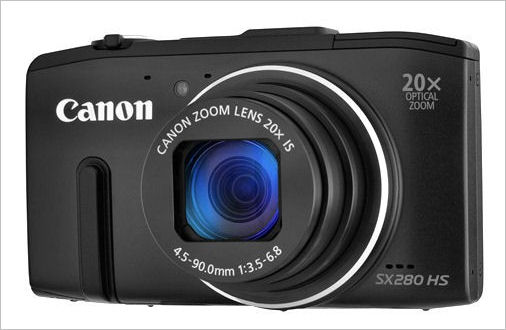
While in England this August I had a chance to test out the new Canon Powershot SX280 HS "in the field". The SX280 HS is Canon's entry in the "pocketable camera with a long lens" class. While the body is a slim 4.19 x 2.47 x 1.28 in. (106.4 x 62.8 x 32.6mm) and the weight is a mere 8.22 oz (including battery and memory card), the lens covers from 25mm to 500mm (in equivalent 35mm terms). This makes it a camera you can take pretty much anywhere and everywhere in your pants pocket, yet which has a lens that good for everything from wideangle landscapes to telephoto wildlife shots.
The downside of course is that it's a small sensor camera and so suffers from the same problems as all small sensor cameras - principally the image quality drops off significantly as the ISO setting is raised due to image noise and/or noise suppression artifacts, but we'll get to that later in the review.
The Canon Powershot SX280 HS has a number of notable features:
- A 12.1 MP 1/2.3" CMOS Sensor
- A 4.5-90/3.5-6.8 lens (equivalent to a 25-500mm lens on 35mm)
- 1080p Full HD video at 60fps
- Built-in WiFi
- Built-in GPS with logging option
- Intelligent Image Stabilization with 6 modes
- 7 full resolution frames in 0.5 seconds in in High-Speed Burst HQ mode
- ISO 80-6400
- Shutter speeds from 15 to 1/3200s (Tv and M), 1-1/3200s in other modes
Full specification can be found on the Canon Powershot SX280 HS Specifications page.
BTW, it's also available in red!
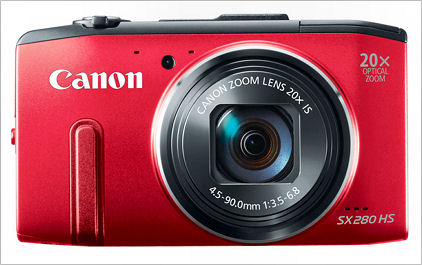
Powershot SX280 HS Controls
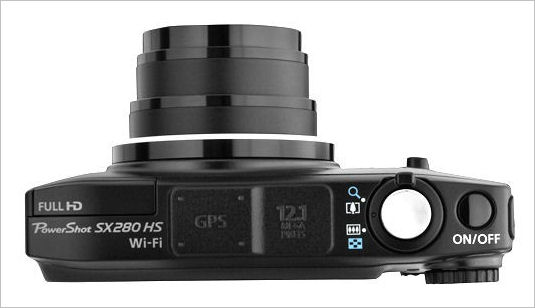
The top deck of the camera doesn't have very many controls. On fact there are only three. There's the on/off button at the extreme right, the shutter release and the zoom ring around the shutter release. You can also see the GPS module in the center.
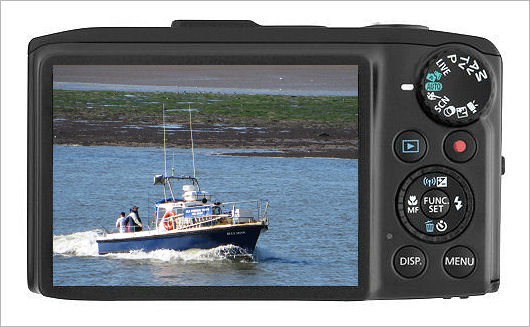
Most of the controls are located on the back of the camera to the right of the LCD. At the top is the main mode control dial. This also acts as a thumb grip, so it's good that the dial is fairly stiff to rotate so that you don't accidentally change modes. Available settings are M, Av, Tv, P, Live View Control, Hybrid Auto, Auto, Sports, SCN, Creative Filters, Discreet and Movie. "Discreet" turns off all the camera sounds.
Directly below the mode control dial are the playback button (on the left) and the video start/stop button (on the right)
Below those is the 4-way controller which has a function/set button in the center and a rotating ring around the outside which can be used to select menu items and/or alter control settings. The 4-way controller give direct access to exposure compensation (top, +/- 2 EV in 1/3 steps), the self timer (bottom), Focus mode (left) and flash settings (right). Less frequently used menu items can be accessed via the menu bottom at the bottom right. The DISP button controls the amount information displayed on the LCD screen.
In continuous exposure mode the SX280 HS can shoot at approximately 3.8 frames/sec if focus is locked on the first exposure. With continuous AF this drops to around 1 frame/sec. However as the "HS" (high speed) designation implies, there is a faster option called High-Speed Burst HQ mode. With focus fixed on the first shot the frame rate is 14 frames/sec, but there is a catch. The catch is that the buffer is only good for 7 frames, so you're only shooting at 14 fps for 1/2 second. That means you still have to time things pretty precisely if you want to catch action. With AF for each shot the frame rate is about 5.1 frames/sec, again with a 7 frame buffer. Again you have to time things right since while in High-Speed Burst HQ mode, once the buffer is filled you can't shoot again for around 3 seconds, so if you miss the action it's likely to be all over by the time you can take another shot.
Image Quality
Image quality is generally quite good, especially at the lower ISO settings. Chromatic aberration, distortion and vignetting are all well controlled throughout the focal length range, though I'm pretty sure that is a consequence of digital processing rather than optical excellence. However without the ability to record in RAW format it's hard to say how hard the DIGIC 6 processor in the SX280 HS is having to work. There is sometimes some slight residual color fringing on high contrast edges and there is also a small amount of purple fringing, but you have to magnify the image quite a lot to see it.
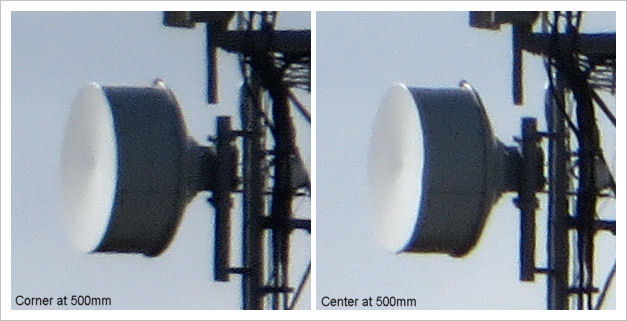
The above are 100% crops from close to the center and the corner of images shot at 500mm (ISO 80) of a distant radio tower. Some of the blurring is due to atmospheric turbulance, but you can see that the corner is very nearly as sharp as the center. Both images do show evidence of slight chromatic aberration.
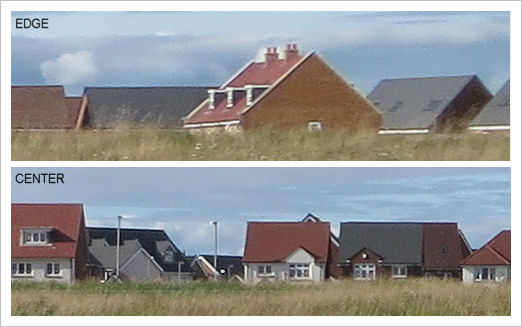
The above samples are 100% crops taken from the center and the extreme edge of the same image shot at 25mm (ISO 80). Again you can see that there's very little change in sharpness and little evidence of chromatic aberration.
Overall the image quality is quite good. Not exceptional, but on a par with similar cameras from other manufacturers. I don't think the lower pixel count (12MP vs. the 16MP or even 20MP of some P&S digicams) is a significant factor. While theoretical resolution might be lower, in practice lens limitations and noise reduction artifacts go a long way to equalizing actual image resolution.
ISO noise
The Powershot SX280HS has a 12MP sensor. That's a lower pixel count than many of its rivals which have sensor counts in the 16-20MP range. However a lower pixel count with the same size sensor means larger pixels and larger pixels generally give lower noise. As expected for any small sensor digicam, image noise makes its presence felt much over ISO 400. The 4 samples below are 100% crops of the image of a wooden door taken at ISO 100, ISO 800, ISO 3200 and ISO 6400:
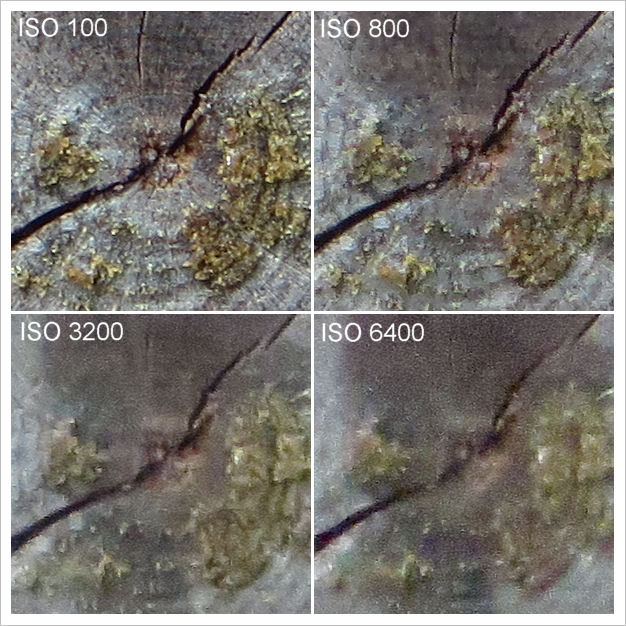
You'll see that in the above image crops noise doesn't actually go up much. However the fairly aggressive noise reduction algorithms smear the image detail more and more as the ISO goes up. At ISO 100 (and ISO 80, 200 and 400) things look quite good. Noise is low and detail is fairly sharp. At ISO 800 you can see a loss of detail due to the smearing of the image in order to reduce noise. At ISO 3200 things are pretty bad when the image is looked at on this scale (100%) and at ISO 6400 things look even worse.
However it's worth remembering that you aren't really going to look at an ISO 6400 from this camera up that close. In fact ISO 6400 is fine for small prints and web sized images as the sample below shows. This has been downsized to 600x450 pixels. It looks just fine.

Canon Powershot SX280 HS at ISO 6400. 1/2000s @ f8
Flare is generally fairly well controlled, but some flare and ghosting is evident under extremely difficult conditions such as with the sun in the frame.
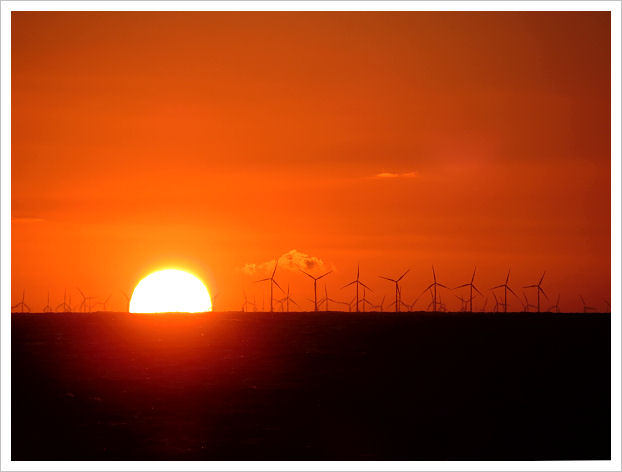
Powershot SX280 HS at 500mm f6.8, 1/250s, ISO 80
Video
The video capability of the SX280 HS is an improvement over that of previous Powershots in that it is capable of recording 1080p HD video at 60fps. This is probably due to the use of the new DIGIC 6 processor in the SX280 HS (the first of Canon's cameras to get it). 60fps can produce smoother video than 30fps and it can particularly be noticed when there is a lot of movement in the frame. There is the option to shoot at 30fps as well as 720 HD at 30fps and VGA (640x480) at 30fps. In addition there are two high speed "slow motion" modes of 640x480 at 120fps and 320x200 at 240fps.
Optical zoom is available while shooting. Though zooming noise can be heard on the audio track, it's at a pretty low level. Two zoom speeds are available, though there's no indication of which speed you are using. Move the zoom ring around the shutter release a little and the zoom is slower, move it more and the zoom is faster but there's no indication of when you switch between the two speeds so it requires practice an a delicate touch. Continuous AF is also available while shooting video. Exposure is basically automatic, though you can set color balance, exposure compensation and some special effects manually.
When first released there were a number of complaints that after a few minutes the SX280 HS battery indicator would flash red low battery warnings and zooming the lens would shut the camera down. Canon addressed these issues via firmware updates. With the 1.0.2.0 update, Canon claims to have fixed the premature display of low battery in movie mode and increased movie shooting capacity by 20% by reducing the power consumption of the zoom mechanism. I measured the following with firmware 1.0.2.0 installed in the SX280 HS, starting out with a fully charged battery and zooming in and out once each minute.
| Start recording | Battery OK | Zoom OK |
| 22 minutes | Low battery indication | Zoom OK |
| 42 minutes | Low battery Indication | Zooming shuts down camera |
| 54 minutes | Camera shuts down |
As you can see, the low battery warning seems to still be a little premature and towards the end of the charge attempting to zoom the lens still causes the video to stop recording and the camera to shut down. So I'm not sure the initially reported issues have been fully fixed, though 42 minutes of video recording with zoom and 54 minutes in total don't seem like bad numbers. It's just if you see the low battery warning flashing you can't really tell if you can keep shooting for another 30 minutes of if the camera will shut down in the next 10 seconds. Not a bad idea to keep a spare battery on hand if you intend to shoot a lot of video.
Conclusions
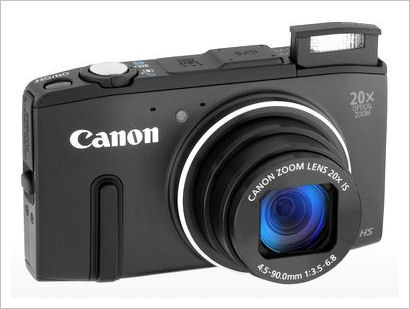
Canon Powershot SX280 HS with flash popped up
Canon have put a lot of features in the SX280 HS and still kept it to a small size and light weight. It has 1080p video at 60fps, WiFi, GPS, a 25-500 zoom lens (in 35mm terms), ISO up to 6400, a high speed burst mode and very decent image quality as long as you don't push the ISO setting too high. And you get all this at a price of around $250.
So is it the perfect camera. Well, no, not really, but nothing is. It's pretty good at what it does and extremely convenient to carry and use and that might be enough for many potential buyers. However it does lack some features I'd like to have seen on a SX series powershot, such as the ability to store images in RAW format and some control over the amount of noise reduction applied to the images. There's also the battery indicator issue when shooting video. Canon have addressed this with a couple of firmware updates and it's better than it was, but it still doesn't quite seem to be fully resolved.
So are there any similar cameras with better performance and/or more features? Well, there's the Panasonic Lumix DMC-ZS30, which has WiFi and GPS, a 24-480/3.3-64 lens and a 20MP sensor and 1080HD at 60fps. However it still doesn't have uncompressed (RAW) image file capability. If that doesn't concern you, then at around $368 it's a pretty good camera - though that makes it over $100 more expensive then the Powershot SX280 HS.
If you want a small, pocketable camera with a wide range zoom and RAW capability I think your choice is limited to the Fuji F900EXR. It has a 25-500/3.5-5.3 lens, a 16MP sensor, 1080 HD at 60fps and sells for around $250. It has WiFi but not GPS built in.
The Sony Cyber-shot DSC-HX50V has a 24-720/3.5-6.3 lens, a 20MP sensor, a hotshoe, 1080 HD at 60fps and built in WiFi and GPS. However it still doesn't have a RAW mode and at around $400 it's about $150 more expensive than the SX280HS.
So the bottom line is, I think, the Canon Powershot SX280 HS, while not perfect, probably delivers the best "bang for the buck" for a small pocketable camera with a wide zoom range and built-in WiFi and GPS.
If you want a fairly small wide zoom range digicam and you don't care too much about size and you don't need WiFi or GPS then my recommendation is still the Canon Powershot SX50 HS that I reviewed here recently - but you won't get it in your pocket!
